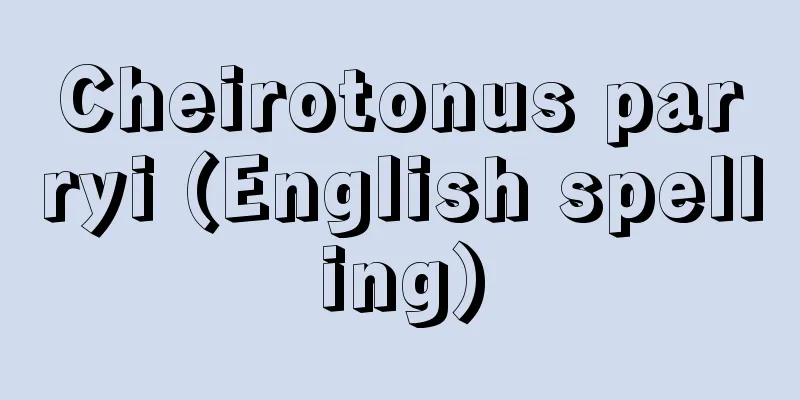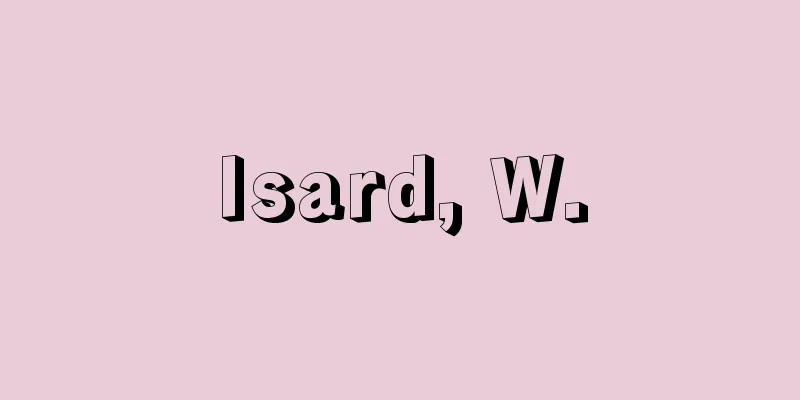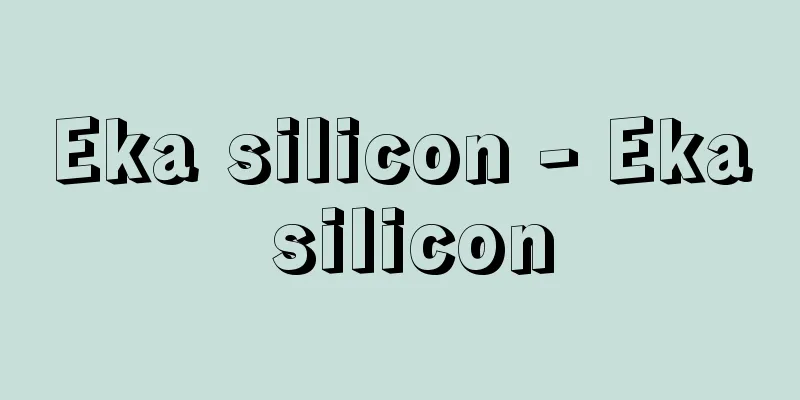Hairstyle - Kamigata

|
Hair styles for men and women are arranged according to changes in daily life, such as for beauty and hygiene reasons, and for special and everyday ceremonies. It goes without saying that since prehistoric times, ethnic groups around the world have had their own distinctive hairstyles. However, as women began to enter the industrial world, they began to seek out hairstyles that were more convenient and more in keeping with daily life, and naturally, lifestyles and hairstyles became similar between countries, a trend that continues to this day. This article gives an overview of the evolution of hairstyles in Japan, and Western hairstyles will be discussed in the "Hairstyles" section. [Takeshi Endo and Yasutada Tsubouchi] Men's hairstylesHairstyles in ancient society are known from human clay figurines that were popular in the 5th and 6th centuries. Before that, the Chinese historical record "Records of the Three Kingdoms" records that people wore hair coverings, but the actual hairstyles can only be known from human clay figurines. Looking at them, the hair is parted from the center of the forehead to the left and right, and tied in an eight shape at the ears. This is what is called "mizura" (midori) in ancient documents. There were two types of this: "age mizura" and "sage mizura". In the Asuka period, Japan adopted the Chinese cultural artifact system, and the crown and rank system, which determines rank and status by the color of the crown, was established. After this, all government officials began to wear crowns and keep their hairstyles natural. Even when the crown and rank system became more complicated and was replaced by the rank and color system, people did not take off their crowns and live with their heads exposed. However, only common people wore their hair in a simple topknot that was tied up and secured with a string. For the leadership classes such as nobles and samurai, it was common to wear crowns and hats, so their hairstyles were the topknot under the crown or the topknot under the eboshi hat (one topknot), which was convenient for that purpose. These hairstyles were done by first lining up the entire head of hair at the 100-point point (the top of the head), then cutting the hair and wrapping it up with a string or a motoyui (braid), and the number and color of the string or motoyui wrapped around it also indicated differences in social status. In the samurai society, as wars dragged on, people began to leave their sakayaki open because their hair would get steamy. However, as the wars ended, people grew out their sakayaki and returned to a crown-shaped topknot or an eboshi-shaped topknot. As samurai life gradually became more stable, samurai families began to adopt the yusoku style of the nobles, and this style reached its peak in the Muromachi period. Meanwhile, conflicts between samurai families broke out again, and the day-and-night fighting that followed after the Onin War began also caused hair to get steamy, forcing people to keep their sakayaki open all the time, so the sakayaki gradually grew larger, taking up more than two-thirds of their hair. This was the turning point that led to the generalization of the custom of wearing the topknot with a loose topknot, which led to the emergence of the chasenmage, where hair is gathered at the back of the head and wrapped with thread. The Tensho period (1573-1592) marked the beginning of a lifestyle with topknots and buns. The famous Rakuchu Rakugaizu Byobu (Scenes in and around Kyoto) (owned by Uesugi Shrine), a gift from Oda Nobunaga to Uesugi Kenshin, shows an early hairdresser plucking the topknot with tweezers. At the time, topknots were not shaved with a razor, but rather with tweezers. This is also recorded in the diaries of Nanban monks. Following Tokugawa Ieyasu's great victory in the decisive Battle of Sekigahara, the Edo period was marked by a period of peace. As feudal society was established, the monetary system spread, and townspeople culture flourished, common people also began to spend money on personal appearances, which led to various changes in hairstyles. In the early Edo period, a unique hairstyle called the tokenbitai emerged among ronin and their rivals, the otokodate, or town slaves, and other hairstyles also became popular, including the wakashumage, gingkomage, yukomagage, semiori, and yaromage. Special styles of sideburns, such as thin itobin or bachibin shaped like a shamisen plectrum, were also popular. From the mid-Edo period, the Tatsumatsu, Honda, and Bunkin styles appeared. The Bunkin-style, which has particularly long roots, was popular with those who frequented the red-light districts, and there were varieties such as the Epidemic Honda, the Mame Honda, and the Daredamareta-style, which looked as if the wearer had a fever. At the end of the Edo period, the Kobusho-style and sokakko styles became popular among patriots who were consumed with the debate over whether to close the country to the outside world or open the ports, and other hairstyles included the Wakadono-style and Ronin-gincho-style. Among the general public, the gincho-mage was at its height, and there were the O-gincho, Ko-gincho, Shari-age, Tsumabane-style, and Encho-mage. The collapse of the Edo Shogunate and the establishment of the Meiji government led to a period of civilization and enlightenment, and a hairstyle called zangiri, which adopted a Western style, appeared. In 1871 (Meiji 4), the government issued an edict requiring people to cut their hair and remove their swords, popularizing the zangiri hairstyle. Incidentally, Emperor Meiji himself adopted the zangiri style on March 20, 1873 (Meiji 6) in response to the edict, and within the same year, 75% of men living in Tokyo had followed suit. At first, soldiers' hair was cut with scissors, with five parts in the front and one part in the back, but as clippers were imported and domestically produced, they began to be shaved around the time of the Sino-Japanese War. Towards the end of the Meiji period, the hairstyles of craftsmen using clippers changed to chan-guri and kaku-guri. Starting with a 7/3 Western hairstyle, hairstyles influenced by foreign films, such as slicked-back, center parting, and side parting, became popular from the Taisho to Showa periods. After World War II, GI cuts (hairstyles worn by soldiers stationed in the country) became popular, and with the spread of permanent waves, men's hairstyles began to be influenced by fashions around the world. In particular, since Japan's barbers and hairdressers' associations (federations) officially joined the CIC (World Federation of Hairdressers and Hairdressers) in 1964, new hairstyles have been announced twice a year, in spring and summer and autumn and winter, by Paris, the source of global hair fashion, and Japan has come to be influenced by these. Furthermore, new hairstyles unique to Japan began to be announced by barbers' associations and various technical research organizations around the country, and men's hairstyles became increasingly diverse and individualized. On the other hand, there was a strong tendency to copy the hairstyles of stars and celebrities. Representative examples include the buzzcut style known as the "Shintaro cut" (also known as the "Shintaro cut"; around 1956) of Ishihara Shintaro, who won the Akutagawa Prize for his novel "Season of the Sun," the long hair style known as the "mushroom cut" of the British rock group The Beatles, who visited Japan in 1966, and the pompadour style with large protruding bangs known as the "pompadour style" of rock and roll pioneer Elvis Presley, which had a major influence on young people in Japan. In the second half of the 1970s, short hair began to become fashionable again, replacing long hair, and actor Shimizu Kentaro's "Kentaro cut" and the "punch perm," in which small curls were made with an iron on short hair, became all the rage. In 1985, the hairstyle of the idol group Checkers' frontman Fujii Fumiya became popular. Since then, unisex hairstyles with permanent waves and coloring have become standard among young men. In the late 1990s, Kimutaku (Kimura Takuya of the idol group SMAP)'s long permed hair became popular. Also, brown hair and spiky hair, which completely overturned the conventional wisdom and values of men's hairstyles, became accepted by the general public, and became established not only among professional athletes and celebrities but also among ordinary young people. [Takeshi Endo and Yasutada Tsubouchi] Women's hairstylesThe clay figurines from the Stone Age are women, and their hairstyles are similar to modern-day updos, but how this relates to hairstyles from the Kofun period is a topic for future research. In ancient documents, the Gishiwajinden indicates that the figures wore head coverings, and among the haniwa clay figurines of people, there are some that have a style that is the prototype of today's Shimada hairstyle. This style is where the hair is tied up in a 100-part style without the front hair, sideburns, or topknot, and then folded back or forward and tied in the middle with a string. However, many people wear their hair hanging down, as described in the Man'yoshu as "my fluttering black hair." During the Asuka and Nara periods, when Chinese culture was actively adopted, it seems that the Chinese style of hair was also widely puffed up. However, after the Heian period, when the missions to Tang China were stopped, the Japanese style returned, and people of all ranks and social classes wore their hair down. Among court ladies, it was normal for hair to be at least 30 centimeters longer than their height, and the "Okagami" records the story of Senyoden no Nyogo (the Empress of Emperor Murakami) whose hair was 4 meters long. However, this was an exceptional case, and in the private sector and in the Imperial Court, it was normal for people who were busy with work, such as the last women and women with low status, to have hair that reached their waists, and tucked the ends of their hair into the waist of their hakama. In the Kamakura period, fewer people had long natural hair, and people needed wigs to tie their long hair. This temporary hairstyle later came to be called "kamoji" in the language of ladies-in-waiting. In the Edo period, the shiitake-ke-tabo style, in which the hanging hair was held in place with a hairpin, was invented, and even a simple method of removing the hairpin and leaving the hair hanging on sunny days was developed. Since hanging hair was inconvenient for women to do their daily work just like men, the Azuchi-Momoyama period saw the development of the Karawa style, which involves tying hanging hair into a ring and fastening it at the back of the head. Furthermore, in the Edo period, after the ban on headgear was imposed, women began to walk around bare-faced, and the Shimada, Hyogo, and Katsuyama styles were born in the pleasure quarters, while the kogai style, which uses a hairpin to tie the hair up, and the Tamamusubi style spread among young people. From the mid-Edo period onwards, the Shimada, Katsuyama, and kogai styles evolved into the Sakikogai style, Marumage, Takenofushi, Shinobumage, Baimage, Ukibune, and simple comb-wrap styles became popular. By the end of the Edo period and the beginning of the Meiji period, the number had grown to over 280 varieties, including Matsuba-gaeshi, Otarai, Ubako, Oshidori, Toujinmage, Tenjin, Warikanoko, Fukagawa, and Yuiwata. In the Meiji era, young women wore the Tojinmage, Fukurasuzume, Momoware, and Yuwata, while married women wore the Ginkgo-gaeshi and Marumage. With the arrival of the Rokumeikan era, Western-style hairstyles appeared, which changed into the Western updo, Western downdo, British knot, Yakaimage, Kagetsumage, Shimodamage, and Nijōsan-kōchi. In the Taisho era, the 7:3 actress topknot appeared. Furthermore, hair irons were imported from the West, and waves became popular, and short hair gradually became popular among "working women." Meanwhile, a topknot called Fugennō was created, which used a saguma (hair insert) to hide the ends of the hair. The hairstyle called Mimikakushi was also popular from the Taisho era through to the Showa era. From around 1935 (Showa 10), electric permanent waves (denkamashi) became popular, replacing branding irons, but with the start of World War II, perms were banned, and people began to refrain from styling their hair. After the war, imitation of Western styles became popular, and the era of cold perms using chemicals came into effect. After World War II, hairstyles for women, like those for men, were influenced by hairstyles around the world, but technical associations in Japan also announced their own unique hairstyles, which became fashion guidelines. In the 1970s, as women began to advance into society, there was a desire to break away from traditional styling methods that required long hours of styling. British hairstylist Vidal Sassoon (1928-2012) rejected the traditional styling techniques that were the basis of styling, which consisted of applying a setting lotion to set the curls or waves on the hair, shaping it with a comb or curler, and then drying it completely with a large kettle-shaped dryer before finishing it. Instead, she introduced a technique called cut and blow, which involved cutting and finishing with a hand dryer, and introduced this hairstyle, which shocked the global beauty world. The hairstyle was characterized by a foundation of geometric straight lines, and she established the three basic techniques of one-length, gradation cut, and layering, making them the foundational techniques of modern beauty. The hairstyles she created have had a major impact on women all over the world. Since then, coloring has become so popular that it is impossible to talk about hairstyles without mentioning color. Color has expanded from traditional single-color dyeing to mesh color, multi-color combinations, and even bleaching, and we are now in the golden age of color. Due to the trend to enjoy color, there are no particularly eye-catching hairstyles, and the mainstream styles are very plain, one-length straight hair, medium-short spiky cut-and-blow hairstyles, and soft hairstyles with gentle permanent waves. In addition, research into medicines has progressed, and people who used to be troubled by curly hair can now get straight hair through hair straightening (straight perms), which has become very popular. Women's hairstyles are currently changing along with the ever-changing fashions of clothing and makeup. [Takeshi Endo and Yasutada Tsubouchi] Children's hairstylesIn ancient times, boys either let their hair grow or cut it short, but from the Asuka period onwards, they tied their hair in styles such as furiwake, hisagohana or tsunoko. Most girls had their hair hanging down or in a furiwake style. In the Heian period, both boys and girls wore their hair parted on either side of the center of the forehead and hanging down in front of their shoulders, called kashiki, or cut and trimmed kashiki at the shoulders, called mezashi (later called kamuro), or binzura, a variation of mizura. It was common for both boys and girls to keep their hair shaved until the age of two for nobles and three for samurai, and for ordinary people to not grow their hair until the early Edo period. Early genre paintings, such as picture scrolls from the end of the Heian period, often depict these changes in hairstyle. It was during the Edo period that children's hairstyles underwent a major change, with boys having styles such as maegami, yakko, bon no kubo (bon no kuso), keshi, abu, hachi, and tonbo. Meanwhile, girls moved from maegami, yakko, and bon no kubo to styles such as sagegami, gingkomage, choucho, and sakikatsuyama. With the start of civilization and enlightenment in the Meiji period, which saw a change in hairstyles for adults, it became common for boys to have their heads shaved or short hair such as ichibun-gari, cut with clippers. Girls had bobbed hair, braided hairstyles, and short haircuts to accompany the change in lifestyle. Shortly after the Second World War, haircuts for boys were almost completely abandoned, and many children started to cut their hair in a boyish style. To protect their heads, there was also an increased tendency to grow their hair long. In the late 1990s, short hairstyles, such as the "Ichiro cut" and "Nakata cut," which imitated the hairstyles of baseball player Ichiro and soccer player Nakata Hidetoshi, respectively, became popular, due to admiration for sports players. Both the short haircuts of sports boys and the long hair style of adults have become established. For girls, bob haircuts were common, with many having their hair styled at barber shops, but from around 1970, the trend towards going to beauty salons grew stronger, and for older girls, perms and colouring became commonplace with the boom in "charismatic hairdressers" in the late 1990s, and hairstyles have become just as diverse as those of adults. [Takeshi Endo and Yasutada Tsubouchi] "Miyako no Fuzoku Shihou" by Sayama Hanshichimaru (1813, Aibunbo)" ▽ "Clothing and Fashion" edited by Ohashi Shintaro (included in "Daily Encyclopedia Volume 6", 1895, Hakubunkan)" ▽ "Miyako Shimbun supplement Miyako no Hana, issues 1-73 (1897-1903, Miyako Shimbunsha)" ▽ "Collection of Hairstyles for Women in Kyoto" edited by Mitani Chozaburo 10th (1913, Tokyo National Museum collection)" ▽ "Reprint of "Ruishu Early Modern Manners and Customs" by Kitagawa Morisada (1934, Saiseikan)" ▽ "History of Japanese Hairstyles and Hair Accessories" by Hashimoto Sumiko (1998, Genryusha)" ▽ "Japanese Hairstyles" edited by the Kyoto Beauty Culture Club (2000, Mitsumura Suiko Shoin)" [References] | | | |Hair | | | | |Kanshita- | | | | | | | | | | | | | | | | | | | | | |Marumage| | | |©Minoru Sugai Main types of hairstyles and their evolution (for men) ©Minoru Sugai Main types of hairstyles and their evolution (women) ©Minoru Sugai Main types of hairstyles and their evolution (children) ©Minoru Sugai Ginkgo Return ©Minoru Sugai Katsuyama topknot ©Minoru Sugai Peach crack ©Minoru Sugai Evening updo ©Minoru Sugai Cotton Source: Shogakukan Encyclopedia Nipponica About Encyclopedia Nipponica Information | Legend |
|
美容、衛生上の立場や、晴、褻(け)の儀式などの生活上の変化に応じて整える、男女の髪の形。有史以前から世界各国の民族は、それぞれ特徴をもった髪形を整えていたことはいうまでもない。しかし、女性が産業界に進出するようになると、生活に密着した軽便さが求められるようになり、生活様式も髪形もおのずから各国の間で似通った形態がとられ、現代に及んでいる。本項では日本の髪形の変遷を概観し、西洋の髪形については「ヘアスタイル」の項で展開する。 [遠藤 武・坪内靖忠] 男性の髪形古代社会の髪形は、5、6世紀に盛行した人物埴輪(はにわ)から知られる。それ以前のことは、中国の史書『三国志』の「魏志倭人伝」(ぎしわじんでん)に被髪をしたことが記されているが、実際の髪形は人物埴輪で知るしかない。それをみると、額の中央から左右に分け、耳のところで8字形に結び留めている。これが古文献でいうところの「みずら」(美豆良)である。これにも「あげみずら」と「さげみずら」の2種類があった。飛鳥(あすか)時代に入り、わが国は中国の文物制度を取り入れ、冠の色によって地位や身分を決める冠位制度が敷かれてから、官吏はみな冠をかぶることになり、髪形は自然にまとめることになった。冠位制度が複雑化して位色制度にかわっても、冠帽を取って露頂生活になるということはなかった。ただ庶民だけは、簡単に束ねて紐(ひも)で留める髻(たぶさ)のような結髪をしていた。公家(くげ)、武家など指導者階級では、冠帽をつけることが普通のことであったから、髪形はそれに都合のいい冠下髻(かんむりしたのもとどり)や烏帽子下髻(えぼししたのもとどり)(一つ髻)が結ばれた。これらの髪形は頭髪全体を百会(ひゃくえ)(脳天)のところでそろえてから髪を切って、紐や元結(もとゆい)で巻き上げる形式をとり、その紐、元結で巻く数や色によっても身分の相違があった。 武家社会となって、戦乱が長引くようになると頭髪が蒸れるところから月代(さかやき)をあけることになった。しかし、これも戦(いくさ)の終了とともに、月代の毛を伸ばして冠下髻や烏帽子下髻に戻った。武家生活がしだいに安定してくると、公家の有職(ゆうそく)に倣って武家に故実が生まれ、これは室町時代に入って大成する。一方、ふたたび武家同士の争いが相次ぎ、応仁(おうにん)の乱突入後の日夜の争いは、頭髪の蒸れを引き起こす原因ともなり、絶えず月代をあけておく必要に迫られ、月代はだんだんと大きくなり、髪の3分の2以上にもなった。これが契機となって、露頂の風俗が一般化し、後頭部で頭髪をまとめて糸で巻き立てる茶筅髷(ちゃせんまげ)の発生につながるようになった。天正(てんしょう)年代(1573~1592)を一つの境として、露頂と髷のある生活が登場してきた。有名な織田信長が上杉謙信に贈った『洛中洛外図屏風(らくちゅうらくがいずびょうぶ)』(上杉神社蔵)には、毛抜きで月代の毛を抜いている、初期の髪結い床(どこ)の姿がみられる。当時の月代は剃刀(かみそり)で剃(そ)るのではなく、毛抜きで抜いた。南蛮僧の日記のなかにもこのことが記されている。 関ヶ原の天下分け目の合戦で、徳川家康が大勝を収めてから、江戸時代の太平の世が築かれた。封建社会が確立し、貨幣制度が普及し、町人文化が盛んになるにつれて、庶民も、身辺を飾ることに金銭を投じるようになって、髪形にもいろいろの変化がもたらされた。江戸時代初期には、浪人とそれに対抗する男伊達(おとこだて)、つまり町奴(まちやっこ)の間から、唐犬額(とうけんびたい)という独特の髪形が生まれ、また若衆髷、銀杏(いちょう)髷、奴髷、蝉折(せみおり)、野郎髷などが流行した。鬢(びん)では、細い糸鬢、あるいは三味線の撥(ばち)の形をした撥鬢という特殊な形も行われた。江戸中期からは辰松(たつまつ)風、本多、文金風が現れた。ことに根を高くする文金風は廓(くるわ)通いの人たちに好まれ、熱病にかかったように透けた疫病本多、豆本多、だまされた風などの種類があった。江戸末期になると鎖国か開港かの論議に明け暮れした志士の間から、講武所風とか総髪がはやりだし、このほか若殿風あるいは浪人銀杏という髪形が行われた。民間では銀杏髷の全盛期で、大銀杏、小銀杏、それにそり下げ、束ね風、あるいは円朝(えんちょう)髷があった。 江戸幕府の崩壊、これに伴う明治新政府の樹立によって文明開化となり、ここに西洋風を取り入れた散切(ざんぎり)という髪形が出現した。政府は1871年(明治4)散髪脱刀令を出し、散切の大衆化を図った。ちなみに明治天皇は1873年(明治6)3月20日、散髪脱刀令に伴って自ら散切スタイルになったが、同年のうちに東京に住む男性の75%が右にならえをした。軍人の髪は初めは前五分、後ろ一分の鋏(はさみ)刈りであったが、バリカンが輸入され、これが国産化されるにつれて、日清(にっしん)戦争を境に丸刈りとなった。明治も終わり近くになってバリカンによる職人たちの髪形は、チャン刈り、角(かく)刈りとなった。一般には七分三分の洋髪に始まって、大正から昭和にかけてオールバック、センターパーティング、サイドパーティングなど、外国映画の影響による髪形が流行した。 第二次世界大戦後にはGIカット(駐留軍兵士のヘアスタイル)が流行し、また、パーマネント・ウエーブの普及により男性の髪形も世界のモードの影響を受けるようになった。とくに日本の理・美容組合(各連合会)が、1964年(昭和39)、CIC(世界・理美容連盟)に正式加盟して以来、世界のヘアモードの発信機関があるパリより、毎年春・夏、秋・冬の2回、ニューヘアラインが発表され、その影響を受けるようになった。また、日本独自のニューヘアラインも理容組合や全国の各技術研究団体から発表されるようになり、男性の髪形もますます多様化、個性化が進んだ。 一方、スターやタレントのヘアスタイルをまねる傾向も強く、その代表的なものには『太陽の季節』で芥川(あくたがわ)賞を受賞した石原慎太郎(しんたろう)の刈上げスタイル「慎太郎カット」(「慎太郎刈り」ともいう。1956年ごろ)や、1966年に来日したイギリスのロック・グループ、ビートルズの長髪スタイル「マッシュルームカット」、ロックンロールの元祖エルビス・プレスリーのフロント(前髪)を大きく突き出した「リーゼントスタイル」などが、日本の若者に大きな影響を与えた。 1970年代後半には、長髪にかわってふたたび短髪が流行し始め、俳優清水健太郎の「健太郎カット」や、ショート・ヘアにアイロンで小さなカールをつくる「パンチパーマ」が一世を風靡(ふうび)した。 1985年にはアイドルグループ、チェッカーズの藤井フミヤのフロントを思いきり遊ばせたヘアスタイルが流行した。以来、若い男性の間ではパーマネント・ウエーブやカラリング(毛染め)などを施したユニセックス(両性的)な髪形が定番となった。1990年代後半には、キムタク(アイドルグループSMAPの木村拓哉(たくや))の長いパーマヘアが人気となった。また、男性髪形の常識や価値観を根底から覆す「茶髪(ちゃぱつ)」「ツンツンヘア」が市民権を得るようになり、プロスポーツ選手やタレントばかりでなく、一般の若者の間にも定着した。 [遠藤 武・坪内靖忠] 女性の髪形石器時代の土偶は女性であり、その髪形も現代の断髪のような形をしているが、これが古墳時代の髪形とどうつながるかは、今後の研究課題である。古文献のうえでは「魏志倭人伝」に被髪をしたことがみえ、人物埴輪のなかには今日の島田髷の祖型的な形をしたものがみられる。これは前髪、鬢(びん)、髱(たぼ)をとらずに百会(ひゃくえ)で総髪を束ねてから、その髪を後ろや前に折り曲げて中央を紐で結んだ形である。しかし、多くの人たちは『万葉集』に「なびく吾(わ)が黒髪」と歌われた垂髪のようである。 中国文化を盛んに取り入れた飛鳥・奈良時代になると、唐風に大きく髪を膨らませることも行われたと思われる。だが、平安時代に遣唐使が停止されてから、日本式に戻るようになり、身分の上下、階級の別なく垂髪となった。公家婦人の間では、髪の長さは身丈よりも30センチメートル以上長いのが普通となり、『大鏡』には髪の長さが4メートルもあったという宣耀殿(せんようでん)の女御(にょうご)(村上(むらかみ)天皇中宮)の話が記されている。しかしこれは特殊な例で、民間や宮中でも、お末(すえ)、はした女(め)などのように仕事に追いまくられる人たちの髪の長さは腰ぐらいまでで、毛先を袴(はかま)の腰に挟むのが普通であった。鎌倉時代に入ると、長髪の地毛をもつ者が少なくなり、長髪を結うための仮髪(かはつ)(鬘(かつら))が必要となった。この仮髪をのちに女房詞(ことば)で「かもじ」というようになった。江戸時代になると、垂髪を笄(こうがい)で留める椎茸髱(しいたけたぼ)が考案され、晴のときには笄を抜いて、垂髪とする簡便法さえできた。 女性が男性と同様に、日常の仕事をするのには、垂髪では不便なので、安土(あづち)桃山時代から、垂髪を輪にまとめて後頭部で留める唐輪(からわ)が生まれた。さらに江戸時代に入り、被(かぶ)り物の禁令後、素顔で歩くようになって、遊里から島田髷、兵庫髷、勝山(かつやま)髷が生まれ、また笄を利用した束髪の笄髷、あるいは玉結びという髪が若い人たちの間に広まった。江戸中期以降になって、島田髷、勝山髷、笄髷から変化した割(さき)笄髷、丸髷、竹の節(ふし)、しのぶ髷、貝(ばい)髷、浮き船、簡単な櫛(くし)巻きなどが行われた。江戸末期には、松葉返し、おたらい、うばこ、おしどり、唐人(とうじん)髷、天神、割り鹿(か)の子、深川、結綿(ゆいわた)など、明治初年にかけてその数は280余種にも及んだ。 明治に入ると、若い女性に唐人髷、ふくら雀(すずめ)、桃割れ、結綿、既婚者には銀杏返し、丸髷などが用いられた。鹿鳴館(ろくめいかん)時代の到来とともに、西洋風の束髪がおこり、西洋上げ巻き、西洋下げ巻き、イギリス結び(巻き)、夜会巻き、花月結び、下田髷、二〇三高地と変わっていった。大正になると、七三の女優髷が現れた。さらに欧米から髪のアイロンが輸入されて、ウエーブがはやり、また断髪が「職業婦人」の間でしだいに普及した。一方、しゃぐま(入れ毛)を利用して髪先がわからないようにした行方不明という髷もできた。耳隠しという髪形も、大正から昭和にかけて流行した髪である。 焼き鏝(ごて)にかわって、1935年(昭和10)ごろから電気パーマネント・ウエーブ(電髪)の流行期に入ったが、第二次世界大戦突入とともにパーマは禁止され、自粛髪時代となった。戦後は欧米模倣が盛んになり、パーマも薬品によるコールド・パーマ時代となった。 第二次世界大戦後の髪形については、男性の場合同様、世界のヘアモードに影響を受ける一方、日本国内でも技術団体がそれぞれ独自の髪形を発表し、流行の指針となっている。 1970年代になると、女性の社会進出に伴い、従来の長時間のセットを要するスタイリングからの解放が望まれた。イギリスのビダル・サスーンVidal Sassoon(1928―2012)は、スタイリングの前提であったセット技術、つまり髪にカールやウエーブを固定させるためのセットローションを塗布し、櫛やカーラーなどで形づけをし、大きな釜形のドライヤーで完全乾燥させたあと仕上げるといったやり方を否定し、カットとハンドドライヤーで仕上げる技法(カット・アンド・ブロー)とその髪形を発表し、世界の美容界を驚かせた。その髪形の特徴は幾何学的な直線で構成されるものが基盤となっており、ワンレングス、グラデーション・カット、レイヤーの三大基本技法を確立、現代の美容基礎技術として不動のものとした。そこから発信される髪形は世界中の女性に大きな影響を与えている。 その後は、カラリングの流行が目覚ましく、カラーなしでは髪形は語れないほどの普及ぶりである。それも従来の単色染めからメッシュカラー、複色配合、あるいはブリーチ(脱色)と多岐にわたり、カラー全盛時代を迎えている。色を楽しむ傾向からとくに目だった髪形はなく、ごくプレーンなワンレングス調のストレート・ヘア、カット・アンド・ブローによるミディアム・ショートの「ツンツンヘア」や緩やかなパーマネント・ウエーブを施したソフトな髪形が主流である。 また、薬品の研究も進み、従来縮毛(くせ毛)で悩んでいた人たちが、縮毛矯正(ストレートパーマ)によってストレート・ヘアが得られるようになり、大いに普及している。女性の髪形は、めまぐるしく移り変わる服装や化粧の流行と変動をともにしているのが現況である。 [遠藤 武・坪内靖忠] 子供の髪形古代の男児は、髪を伸びるに任せるか、短く切っていたが、飛鳥時代以降、振分け髪、ひさご花、角子(つのこ)などの髪に結った。また女児は、ほとんどが垂髪にするか、振分け髪であった。平安時代になってから、男女とも髪を額中央から左右に分けて、肩の前に垂らした喝食(かっしき)、あるいは喝食を肩のところで切りそろえた目ざし(後世の禿(かむろ))、みずらの変化した「びんずら」などにしていた。公家は2歳、武家は3歳の髪置祝いが済むまでは、男女ともに髪を伸ばさない丸坊主が普通であり、民間でも江戸初期まで頭髪は伸ばさなかった。平安末期の絵巻物など初期風俗画のなかに、この髪形の変容がよく描かれている。 子供の髪形が大きく変化してくるのは江戸時代に入ってからで、男児は前髪、奴(やっこ)、盆の窪(くぼ)(盆のくそ)、芥子(けし)、あぶ、はち、とんぼなどがあった。一方、女児は前髪、奴、盆の窪から、下げ髪、銀杏髷、蝶々(ちょうちょう)、割勝山(さきかつやま)などの髪形にした。大人の髪形が変化する明治の文明開化とともに、男児は丸刈り、一分刈りのような短い髪にバリカン刈りすることが普通となった。女児はおかっぱ、お下げ、断髪などが生活の変化に伴って行われた。 第二次世界大戦後しばらくすると、男児の髪形は、バリカン刈りはほとんど行われなくなって、坊ちゃん刈りにする子供が多くなり、頭部を保護する意味合いからも、髪を伸ばす傾向が増加した。1990年代後半には、スポーツ選手への憧(あこが)れから、野球選手のイチローやサッカー選手の中田英寿(ひでとし)の髪形をそれぞれまねた「イチローカット」や「ナカタカット」など、ショートの髪形が人気をよんだ。スポーツ少年などのショートヘアと、大人と同じ系統のロングヘアがともに定着している。 女児については、理容店で整髪するおかっぱ型が多かったが、1970年(昭和45)ごろから美容室へ行く傾向が強まり、比較的年長の女児などは、1990年代後半の「カリスマ美容師」ブームに乗ってパーマやカラリングが常識化し、その髪形も大人と変わらず多様な広がりをみせている。 [遠藤 武・坪内靖忠] 『佐山半七丸著『都風俗化粧法』(1813・愛文房)』▽『大橋新太郎編『衣服と流行』(『日用百科全書 第6巻』所収・1895・博文館)』▽『都新聞付録『都の華』1~73号(1897~1903・都新聞社)』▽『十世三谷長三郎編『京都婦女髪形集』(1913・東京国立博物館蔵)』▽『喜多川守貞著『類聚近世風俗志』復刻版(1934・更生閣)』▽『橋本澄子著『日本の髪形と髪飾りの歴史』(1998・源流社)』▽『京都美容文化クラブ編『日本の髪型』(2000・光村推古書院)』 [参照項目] | | | | | | | | | | | | | | | | | | | | | | | | | | | | | | | | | | | |©須貝 稔"> 髪形のおもな種類と変遷(男性) ©須貝 稔"> 髪形のおもな種類と変遷(女性) ©須貝 稔"> 髪形のおもな種類と変遷(子供) ©須貝 稔"> 銀杏返し ©須貝 稔"> 勝山髷 ©須貝 稔"> 桃割れ ©須貝 稔"> 夜会巻き ©須貝 稔"> 結綿 出典 小学館 日本大百科全書(ニッポニカ)日本大百科全書(ニッポニカ)について 情報 | 凡例 |
<<: Kamigata dialect - Kamigata
Recommend
Ukemi (Judo)
… When learning the techniques of judo, the most ...
Ouchiwan - Ouchiwan
These bowls have been passed down through the Mori...
INH - INH
《 isonicotinic acid hydrazide 》⇒ isonicotinic acid...
Bhaktapur
...The capital city of Bhaktapur district in the ...
Pattern recognition
It is the act of looking at pattern information s...
Sardanapalos; Sardanapallus
The last of the 30 Assyrian kings mentioned by the...
Construction work - Sakuji
〘noun〙① To build or repair palaces, houses, etc. C...
Androgeōs (English spelling)
…son of Zeus and Europa. With his wife Pasiphae, ...
Pepsinogen
…A proteolytic enzyme that is active in the acidi...
Rubeshibe [town] - Rubeshibe
A former town in Tokoro County, eastern Hokkaido. ...
Drooping - Drooping
[1] 〘Ta-ru〘Ta-ru ① To support one end of something...
Austenitic Steel - Austenitic Steel
…(2) The second effect is to increase the variety...
English Dictionary
...It attracted attention as a general English di...
papilla
… The skin of vertebrates is made up of two layer...
Gratitude - Onryo
In the Middle Ages, land was given to servants by ...









